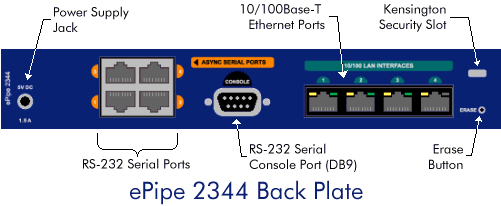
Appendices |
|
|||||
This chapter provides various useful information related to the ePipe product and its technology. This includes:
Cables and Connectors includes illustrations and diagrams of cables and connector pin assignments.
There are 6 models in the ePipe 2000 Family. The Ethernet and RS-232 serial ports applicable to each model are summarised in the table below:
2344 - 4 x 10/100 4 1
Female RJ45
RJ45 Pin Assignments Pin Signal 1 Receive (positive) 2 Receive (negative) 3 Transmit (positive) 6 Transmit (negative)
Female RJ45
RJ45 Pin Assignments Pin Signal 1 Transmit (positive) 2 Transmit (negative) 3 Receive (positive) 6 Receive (negative)
(Hub to Device)
(Hub to Hub)
The RS-232 serial communications protocol defines two classes of equipment: data terminal equipment (DTE) and data communications equipment (DCE).
DCE devices include modems and other communications equipment.RS-232 signal assignments are designed for communications between DTE and DCE devices. A connector pin defined as an output for a signal from a DTE device is defined as an input for that signal on a DCE device, and vice versa. Data communication between an ePipe and a modem is an example of DTE-to-DCE communications.
Male DB-9
DB-9 Pin Assignments Pin Signal 1 DCD - Data Carrier Detect 2 RXD - Receive Data 3 TXD - Transmit Data 4 DTR - Data Terminal Ready 5 GND - Signal Ground 6 not connected 7 RTS - Request to Send 8 CTS - Clear to Send 9 not connected
Female RJ45
RJ45 Pin Assignments Pin Signal 1 DCD 2 RTS 3 Chassis Ground 4 TxD 5 RxD 6 Signal Ground 7 CTS 8 DTR
Note: The 8 pin RJ45 female connector will also mate with RJ12 male connectors. The RJ12 has six pins and will connect with pins 2-7 on the RJ45.
For software handshaking you can use any RJ connector. For hardware handshaking you must use an RJ12 or RJ45 connector. For modems using all of the above lines, you must use an RJ45 connector with 8 pins.
The following cables can be used for connecting ePipe's to external modems and ISDN T/A's.
Asynchronous Modem Cable DB25 - RJ45:
(Two (2) supplied with appropriate models. More can be ordered.)
Asynchronous Modem Cable DB9 - RJ45:
ePipe is equipped with a Kensington Security Slot for physical security The slot is located at the rear of the ePipe indicated by the Kensington Security symbol (see figure below).

Further information and ordering of Kensington Slot Security accessories is available from the Kensington web site.
The figure below shows the location of the Kensington Security slot for the ePipe 2344.

|
Warning: |
Lithium Battery Disposal Instructions |
|
|
CAUTION. DANGER OF EXPLOSION IF BATTERY IS INCORRECTLY REPLACED. REPLACE ONLY WITH THE SAME OR EQUIVALENT TYPE RECOMMENDED BY THE MANUFACTURER. DISPOSE OF USED BATTERIES ACCORDING TO THE MANUFACTURER'S INSTRUCTIONS. |
|
Warning:
|
This is a Class A product. In a domestic environment, this product may cause radio interference, in which case, the user may be required to take appropriate measures. |
Meets requirements of :
| CE mark, commercial |
| EN 55022 : 1998 |
| FCC Part 15, Class A |
| CISPR 22 : 1997 |
| AS/NZS3548 :1995 Amendments 1 & 2 : 1997 |
Note: This equipment has been tested and found to comply with the limits for a Class A digital device, pursuant to Part 15 of the FCC rules. These limits are designed to provide reasonable protection against harmful interference when the equipment is operated in a commercial environment. This equipment generates, uses, and can radiate radio frequency energy. If it is not installed and used in accordance with the instruction manual, it may cause harmful interference to radio communications. Operation of this equipment in a residential area is likely to cause harmful interference, in which case users will be required to take whatever measures may be necessary to correct the interference at their own expense.
This is to certify that the ePipe models 21XX and 22XX are shielded against the generation of radio interference in accordance with the application of Council Directive 89/336/EEC, Article 4a. Conformity is declared by the application of EN55 022 Class A (CISPR 22).
| CE mark, commercial | ||
| EN 55024 : 1998 | ||
| CISPR24 : 1997 | ||
| IEC61000 | -4-2 | Electrostatic Discharges |
| IEC61000 | -4-3 | Radiated RF Fields |
| IEC61000 | -4-4 | Electrical Fast Transients |
| IEC61000 | -4-5 | High Voltage Surges |
| IEC61000 | -4-6 | Conducted Disturbances |
| IEC61000 | -4-11 | Voltage Dips and Interruptions |
| UL 1950 |
| CSA 22.2 #950 |
| TUV (EN 60950) |
| AS 3260 |
Up: Table of Contents .
![]()
about ePipe | products | solutions | support | information center | contact us
Copyright © 2002 ePipe Pty. Ltd. All rights reserved.